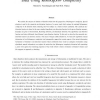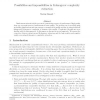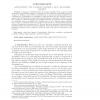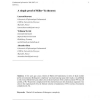CIE
2011
Springer
13 years 7 months ago
2011
Springer
Abstract. In [She82], it is shown that four of its basic functional properties are enough to characterize plain Kolmogorov complexity, hence obtaining an axiomatic characterization...
TIT
2010
14 years 1 months ago
2010
We examine the structure of families of distortion balls from the perspective of Kolmogorov complexity. Special attention is paid to the canonical rate-distortion function of a so...
TCS
2010
14 years 1 months ago
2010
We revisit the notion of computational depth and sophistication for infinite sequences and study the density of the sets of deep and sophisticated infinite sequences. Koppel defin...
CORR
2011
Springer
14 years 2 months ago
2011
Springer
Randomness extraction is the process of constructing a source of randomness of high quality from one or several sources of randomness of lower quality. The problem can be modeled ...
CORR
2010
Springer
14 years 4 months ago
2010
Springer
We survey diverse approaches to the notion of information: from Shannon entropy to Kolmogorov complexity. Two of the main applications of Kolmogorov complexity are presented: rand...
SIAMCOMP
1998
14 years 6 months ago
1998
A language is L-printable if there is a logspace algorithm which, on input 1n, prints all members in the language of length n. Following the work of Allender and Rubinstein [SIAM J...
RSA
2000
14 years 7 months ago
2000
We show the existence of various versions of expander graphs using Kolmogorov complexity. This method seems superior to the usual probabilistic construction. It turns out that the...
CORR
2004
Springer
14 years 7 months ago
2004
Springer
The elementary theories of Shannon information and Kolmogorov complexity are cmpared, the extent to which they have a common purpose, and where they are fundamentally different. T...
CORR
2006
Springer
14 years 7 months ago
2006
Springer
Classical rate-distortion theory requires knowledge of an elusive source distribution. Instead, we analyze rate-distortion properties of individual objects using the recently devel...
FUIN
2008
14 years 7 months ago
2008
A few years ago a nice criterion of Martin-L




